Many observers have been impressed with UAW President Shawn Fain’s astute strategy of using selective strikes, rather than calling all of his members off the job. The strategy has three significant tactical benefits.
First, it conserves the strike fund, which would only last about 90 days if all workers were out. This in turn lets management know that the union can take a longer strike and increases the UAW’s bargaining leverage.
Second, it also allows the union to inflict the most damage for the least cost by taking advantage of supply chain vulnerabilities, as when a key parts supplier or a plant producing popular cars in short supply is shut down. Already, the shutdown of facilities that supply other facilities has led GM and Ford to temporarily shut down two assembly lines. (The companies are denying laid-off workers the partial pay they normally offer when idling plants, which the UAW has called a strategic attack. The union has guaranteed those workers some income.)
And third, management not knowing which plant will be struck keeps the companies off-balance.
As it happens, this original idea is not quite original to the UAW. It was pioneered by the Association of Flight Attendants in 1993, in a strike against Alaska Airlines, where negotiations had been dragging on for three years in the face of huge company profits.
The flight attendants named their strategy CHAOS, which stands for “Creating Havoc Around Our System.” They even trademarked the name.
I write about this tactic in more detail in a forthcoming Prospect feature piece on the Flight Attendants. Here are the basics:
Because labor relations in the airlines are governed by the Railway Labor Act, the union can call intermittent mini-strikes, with no warning to management, designed to inflict maximum damage. If flight attendants walk off the job just as a flight is boarding, the entire system backs up, because of the airlines’ profit-maximizing strategy of getting rid of all of the system’s slack—no spare planes, no extra crews.
The first CHAOS strike took place at Sea-Tac Airport in August 1993, when three flight attendants abruptly left an Alaska Airlines flight just as passengers began boarding. Three days later, attendants walked off the last Alaska flight out of Las Vegas. In September, AFA targeted five flights simultaneously in San Francisco.
The 25 striking flight attendants all were summarily fired. But Alaska could not withstand the chaos and the passenger loss of confidence. It soon caved. So did AirTran, US Airways, America West, and Midwest Airlines, on the eve of threatened CHAOS strikes. All the flight attendants got their jobs back as part of the Alaska settlement.
Today, Alaska Airlines is again making record profits and is again stonewalling the union. In August, there were picket lines at all of the major airports served by Alaska. Flight attendants were joined by their brothers and sisters from dozens of other union locals and allied progressive groups.
The signs read, “Pay us or CHAOS.”
The UAW doesn’t have quite the same leverage. Under the National Labor Relations Act, it cannot call intermittent strikes; the plants currently out must stay out until an agreement is reached. But the premise of keeping management guessing and using selective strikes that cascade through their systems is familiar.
In today’s economy, the unions are going to need every bit of this kind of militant creativity and solidarity, from airlines to autos to trucking to warehousing to fast food.
[Robert Kuttner is co-founder and co-editor of The American Prospect, and professor at Brandeis University’s Heller School.]
Read the original article at Prospect.org.
Used with the permission. © The American Prospect, Prospect.org, 2023. All rights reserved.
Support the American Prospect.
Click here to support the Prospect's brand of independent impact journalism


Spread the word